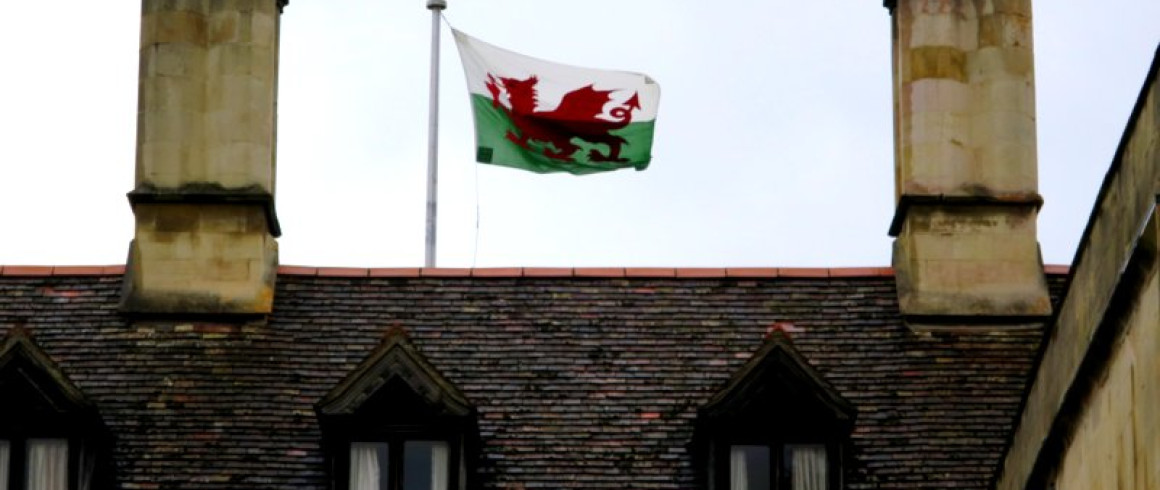Where is St David?
 By Ben Guy (2013), PhD Student in Anglo-Saxon, Norse & Celtic
By Ben Guy (2013), PhD Student in Anglo-Saxon, Norse & Celtic
On the evening of the 1st of March, in a little house on Hobart Road, five friends will gather for a celebratory meal. They gather in honour of a ‘national’ day, notwithstanding their own diverse national origins. Their unity derives not from a shared heritage, but from a genuine fascination with Welsh culture, language and history. The occasion, of course, is the feast day of St David, patron saint of Wales.
But if your local shop hasn’t yet sold out of leeks and daffodils, it might be because St David hasn’t travelled very far beyond his country’s bounds. It’s probably fair to say that, on a national level, Wales is the least visible of the nations of the British Isles. Scotland has its tartans and its bagpipes, its haggis and its Burn’s Night, and even its national mythology (sponsored by Mel Gibson in a kilt). Ireland, though a land of two sovereign states, nonetheless exports a single cultural package to the world, as unmistakable as it is green. And England is England. Or, as the Americans would say, England is Britain, though somehow there is Scotland too, and something to do with Ireland. Just don’t ask them about Wales.
The same arguably applies to saints’ days. St George and St Andrew gave us their flags, which gave us the Union Jack. And St Patrick’s day needs no qualification. In the modern English-speaking world, St Patrick seems to have morphed into the patron saint of getting-drunk-on-the-17th-of-March, as attested by the plethora of novelty Irish cocktails available from a good drinking establishment near you. One wonders what Patrick himself would have thought, God-fearing missionary bishop that he was.
[caption id="attachment_23604" align="alignright" width="225"] The Welsh flag was flown above Pembroke on St David's Day for the first time this year[/caption]
The Welsh flag was flown above Pembroke on St David's Day for the first time this year[/caption]
What of St David? Ironically, he’s the only one among them who came from his country of patronage. St Andrew was an apostle, St Patrick was a Romano-Briton, and St George, naturally enough, was a dragon-slaying Roman soldier. St David, on the other hand, did what it says on the tin. He was a local Christian holy man from south-west Wales, whose most famous miracle involved a mound being raised up beneath him so that he could be better heard by the people gathered around him. He was a preacher with divinely sanctioned PR. And the Lord said unto him, “Let Wales have an extra hill.”
This is not to say that David is more ‘authentic’ as a national saint than any other, even if a particular brand of Welsh nationalism might put it that way. The same brand of nationalism might claim that ‘the Welsh’ are the original inhabitants of the island of Britain, from before the Anglo-Saxons arrived in their bloodthirsty hoards, and that the Welsh language is ennobled by being one of the most ancient languages in Europe. It’s all historical nonsense, of course. People like to seek legitimisation by situating their ideas within a cultural or national narrative stretching back into the dim and distant past, but rarely, if ever, does this narrative equate to the lived experience of any particular population over time. And in any case, Welsh is an Indo-European language, and so by definition is exactly the same age as most other European languages, English included.
But where is Wales in the UK, if bereft of her legitimist past? The United Kingdom was born on the 1st of May 1707, when the kingdoms of England and Scotland were united as one. St George and St Andrew endorsed the Union with their flags. St David was nowhere in sight. The national narrative would suggest that this was because England had conquered Wales in 1282. Another narrative would be less definitive; perhaps it is irrelevant that a family of Williams, Henrys and Edwards came to dominate large areas of Europe and the isles to the north west during the middle ages, and that, as a consequence, one of the political units of 1707 contained a substantial Welsh cultural group. Was St David brought under the yoke, or did he have other things on his mind? The difference is important. By the same historical happenstance, the people of Wales currently find themselves living in a country that half of the Scots want leave, and a European Union that half of the English want to leave. Where is St David in all of this?
This brings us back to Hobart road: why should five friends, three of whom aren’t even from Wales, wish to celebrate a saint whose presence is barely felt outside of the small sub-nation of Wales? The answer lies more in the cultural than the political sphere. Cultural affinity, however it’s acquired, locates a person in time and space, and, crucially, forges bonds with other people. Herein also lies the great challenge: to ensure that those bonds bind us together without separating us from them, Welsh from English, Welsh from British, Welsh from human.
And here we find St David, standing on the mound where he’s been all along. Not as an international celebrity, nor as a nationalist instrument, nor even as a symbol of politico-cultural self-determinism, but as a tiny, priceless segment of diversity within a much greater whole. One is reminded of the words of Rhygyfarch, David’s eleventh-century biographer, describing the journey of David and his companions through Europe to the Middle East: “They were equals as fellow-travellers, no one considered himself to be above the other, each one of them was a servant, each one master. Constant in prayers, they watered the road with tears. The further their feet took them, the greater was their gain. They had one mind, one joy, and one sorrow.”
